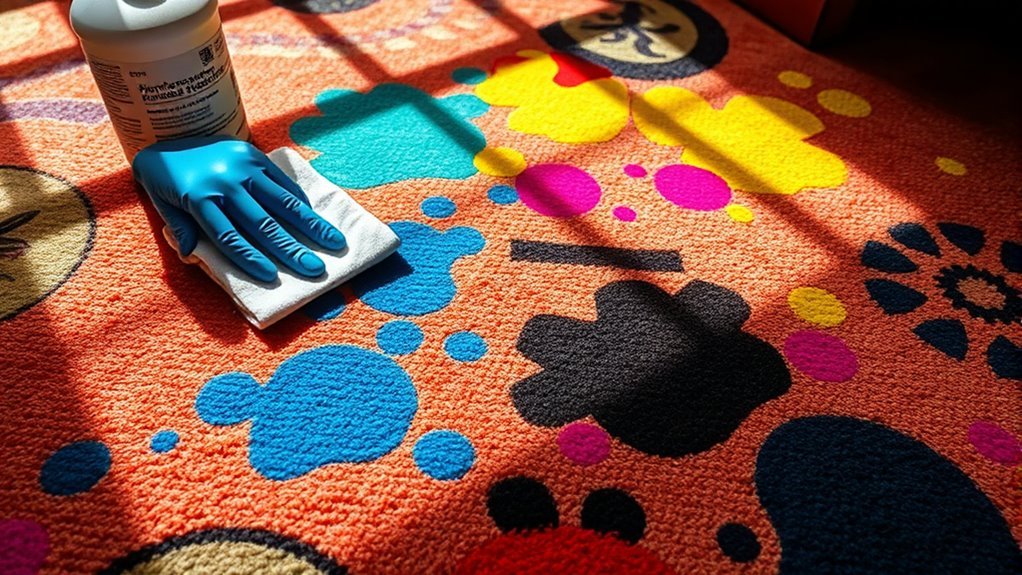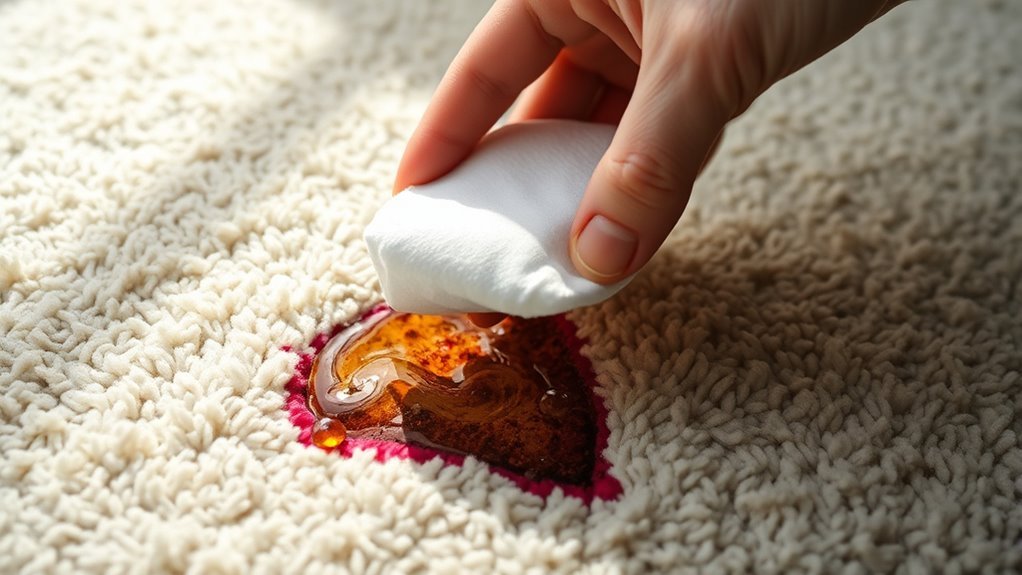Removing Printer Stains From Carpets
To remove printer ink stains from carpets, identify the ink type first—dye-based, pigment, or solvent. Immediately blot excess ink with a clean, white cloth; avoid rubbing to prevent spread. Use dish soap mixed with warm water for light stains or apply rubbing alcohol carefully for tougher spots, testing first on a hidden area. Employ blotting, not scrubbing, and dry thoroughly. If needed, commercial cleaners can be safe when used correctly. You’ll find more detailed methods and tips ahead.
Identifying Different Types of Printer Ink Stains

Before you can effectively remove printer ink stains from carpets, you need to identify the type of ink involved. Identifying ink types is essential because different inks—such as dye-based, pigment-based, or solvent-based—react uniquely to cleaning agents. Dye-based inks tend to spread and soak deeply, creating irregular stain patterns, while pigment inks often sit on the surface with sharper edges. Solvent-based inks may have a glossy or sticky texture. By recognizing stain patterns—such as color intensity, spread, and texture—you’ll know which cleaning method to apply. This precise identification empowers you to select appropriate treatments without causing damage, giving you the freedom to restore your carpet effectively. Accurate identification is the foundation for any successful stain removal strategy.
Immediate Steps to Take After a Printer Ink Spill
When printer ink spills on your carpet, you should immediately blot the stain with a clean cloth to absorb excess ink without spreading it. Avoid rubbing the stain, as this can push the ink deeper into the fibers. Use cold water to dampen the area, which helps prevent the ink from setting while preparing for further cleaning.
Blot Ink Quickly
Although printer ink stains can set quickly, you should blot the spill immediately to prevent further absorption into the carpet fibers. Employing an effective blotting technique with quick action minimizes permanent damage. Use a clean, white cloth or paper towel to gently absorb the ink without spreading it.
| Schritt | Action |
|---|---|
| 1 | Grab absorbent cloth |
| 2 | Press gently on the spill |
| 3 | Replace cloth as it soaks |
| 4 | Repeat until no more ink lifts |
| 5 | Avoid wiping or rubbing |
This precise approach guarantees you’re not pushing ink deeper. Acting swiftly gives you the freedom to maintain your carpet’s appearance and prevents costly replacements.
Avoid Rubbing Ink
Two critical actions you must avoid immediately after a printer ink spill are rubbing or scrubbing the stain. When you rub, you increase ink dispersal, pushing the ink deeper into carpet fibers rather than allowing controlled ink absorption to occur. This action spreads the stain over a larger area, complicating removal and potentially damaging the carpet’s texture. Instead, focus on gentle blotting techniques that restrict ink movement and promote absorption onto a clean, white cloth or paper towel. Avoiding rubbing preserves the integrity of the carpet fibers and prevents the ink from setting permanently. Maintaining this discipline during the initial response maximizes your chances of fully removing the stain and retaining your carpet’s appearance and freedom from lasting damage.
Use Cold Water
Since ink stains can set quickly, you should immediately apply cold water to the affected area to prevent permanent damage. Cold water techniques effectively dilute printer ink, slowing its absorption into carpet fibers. Avoid hot water, as it can fix the stain by causing ink pigments to bind more tightly. Using a clean cloth or sponge, gently blot the spill with cold water—don’t rub—to lift ink particles without spreading them. The cold water benefits include minimizing stain setting and preserving carpet integrity. After applying cold water, continue blotting until no more ink transfers. This method gives you control over stain removal without harsh chemicals, maintaining your freedom to manage spills efficiently and safely. Employing cold water immediately is the most reliable first step in preserving your carpet’s appearance.
Essential Cleaning Supplies for Ink Stain Removal
Before tackling ink stains on your carpet, you’ll need to gather specific cleaning supplies designed to break down and lift ink particles effectively. Essential ink cleaning supplies include isopropyl alcohol or rubbing alcohol, which dissolves the ink without damaging carpet fibers. You’ll also want a clean white cloth or paper towels to blot the stain without spreading it. For precise application, a spray bottle can help control the amount of cleaning solution used. Additionally, having a soft-bristled brush or a sponge as stain removal tools aids in gently agitating the affected area, enhancing ink lift. Gloves protect your hands during the process. These carefully chosen supplies guarantee you can target printer ink stains efficiently while preserving your carpet’s integrity, granting you freedom from stubborn blemishes.
Using Dish Soap and Warm Water to Treat Ink Stains

You’ll start by mixing a small amount of dish soap with warm water to create a gentle cleaning solution. Apply the mixture carefully to the stained area without oversaturating the carpet fibers. Then, use a clean cloth to blot the stain, working from the outside in, and allow the area to dry thoroughly.
Preparing Soap Solution
Mixing a soap solution is a straightforward yet vital step in treating printer ink stains on carpets. Begin by selecting a mild dish soap, as its formulation effectively breaks down ink without damaging fibers. The ideal solution ratios are typically one teaspoon of dish soap per one cup of warm water. This balance guarantees the soap consistency is thin enough to penetrate carpet fibers but concentrated enough to lift ink. Stir gently until fully blended, avoiding excessive agitation that may create foam, which can complicate application. Maintaining the correct soap consistency is essential; overly thick mixtures might saturate the carpet, while overly diluted solutions lose effectiveness. By preparing this solution accurately, you’ll maximize stain removal efficiency while preserving carpet integrity.
Applying Mixture Safely
Once your soap solution is prepared with the correct concentration, applying it to the ink stain requires careful technique to avoid spreading or embedding the stain further. To guarantee effective and safe application, follow these safety precautions:
- Test a small, inconspicuous carpet area to verify that the cleaning solution doesn’t cause discoloration or damage.
- Use a clean white cloth or sponge, gently dabbing the stain—never rub—to prevent ink from spreading deeper into fibers.
- Apply the mixture sparingly; excessive moisture can weaken carpet backing or promote mold growth.
Always wear gloves to protect your skin from prolonged contact with cleaning solutions. By maintaining precision and observing these safety precautions, you’ll maximize stain removal effectiveness while preserving your carpet’s integrity and your freedom from harsh chemicals.
Blotting and Drying
Although dish soap and warm water provide an effective cleaning combination for ink stains, careful blotting is essential to prevent spreading the stain further. Start by gently pressing a clean, white cloth onto the stained area, using blotting techniques that lift the ink without rubbing it deeper into the carpet fibers. Replace the cloth frequently to avoid reintroducing ink back onto the carpet. After you’ve absorbed as much ink as possible, apply drying methods that promote rapid moisture evaporation. Use a dry cloth to press the area again, then allow the carpet to air dry completely. Avoid heat sources that may set any residual stain. By combining precise blotting techniques with controlled drying methods, you maintain the carpet’s integrity while effectively removing printer ink stains.
Applying Rubbing Alcohol for Tough Ink Spots

How do you effectively tackle printer ink stains that won’t budge with standard cleaning methods? Using rubbing alcohol is a proven technique for tough ink removal on carpets. Here’s how you can apply it safely and efficiently:
- Test First: Apply a small amount of rubbing alcohol to an inconspicuous carpet area to verify it won’t damage fibers or colors.
- Apply and Blot: Dampen a clean white cloth with rubbing alcohol and gently blot the ink stain. Avoid rubbing, which can spread the ink.
- Rinse and Dry: After the ink lifts, blot the area with a cloth dampened in water to remove residue, then dry completely using a fan or air circulation.
This method gives you precise control over ink removal, preserving your carpet’s integrity while freeing you from stubborn stains.
How to Use Commercial Carpet Cleaners Safely
Before applying any commercial carpet cleaner, you’ll want to thoroughly read the product instructions and test it on a hidden section of your carpet to confirm compatibility with the fibers and colors. Adhering to commercial product safety guidelines guarantees effective stain removal without damaging your carpet. Use recommended carpet cleaning techniques such as blotting instead of rubbing and ventilating the room during application.
| Schritt | Precaution |
|---|---|
| Read Instructions | Follow manufacturer guidelines |
| Patch Test | Avoid discoloration or damage |
| Use Proper Ventilation | Prevent inhalation of fumes |
Preventative Measures to Avoid Future Printer Ink Stains
Since printer ink stains can be difficult to remove once set, taking preventative measures is essential to protect your carpet. To maintain freedom from stubborn stains, consider these technical steps:
- Apply ink resistant treatments specifically designed for carpets; these form a protective barrier that repels ink and facilitates easier cleaning.
- Use protective carpets or mats under and around your printer to contain any accidental spills, minimizing direct contact with the carpet fibers.
- Regularly inspect and maintain your printer to prevent leaks or ink cartridge malfunctions that could cause unexpected staining.
When to Call Professional Carpet Cleaners for Ink Removal
Even with preventive steps in place, some printer ink stains can penetrate deeply or spread extensively, making DIY removal ineffective. You should know when to call professional carpet cleaners to avoid permanent damage. Key signs for professionals include large or old stains that have set, discoloration resistant to household solvents, or ink spreading beyond the initial spot. If your attempts cause the stain to worsen or you’re unsure about the carpet fiber’s tolerance to cleaning agents, that’s another indication it’s time to seek expert help. Professionals use specialized solvents and equipment designed for deep penetration and safe extraction, preserving your carpet’s integrity. Recognizing these signs for professionals guarantees you maintain your carpet’s appearance and prolong its lifespan without risking costly mistakes.
Häufig gestellte Fragen
Can Printer Ink Stains Cause Permanent Carpet Discoloration?
Imagine a fresh carpet beside one marred by dark blotches—this contrast highlights how ink absorption can lead to permanent discoloration. When printer ink penetrates carpet fibers, it binds deeply, making stain removal challenging. Unless you act swiftly with appropriate solvents, the pigments may set permanently, altering the carpet’s original color. So, if you want to preserve your carpet’s freedom from stains, prompt and precise treatment is essential to prevent lasting damage.
Are There Eco-Friendly Alternatives to Commercial Carpet Cleaners?
You can definitely opt for eco-friendly alternatives when cleaning carpets. Natural cleaning solutions like vinegar and baking soda effectively break down stains without harsh chemicals. Green cleaning products, often plant-based and biodegradable, offer powerful stain removal while reducing environmental impact. These options let you maintain a clean carpet and preserve your freedom from toxic substances. Always test a small area first to verify compatibility with your carpet fibers.
How Long Does It Take for Ink Stains to Set in Carpet Fibers?
You might think ink stains set instantly, but ink absorption into carpet fibers actually begins within minutes and can continue up to several hours. The quicker you act, the better your chances for effective stain removal, as the ink penetrates deeper over time, making it tougher to eliminate. Understanding this timeline empowers you to tackle stains promptly and maintain your carpet’s freedom from permanent damage.
Can Homemade Remedies Damage Carpet Materials?
Yes, homemade remedies can damage carpet materials if you’re not careful. Some ingredients, like vinegar or bleach, might weaken fibers or cause discoloration depending on the carpet type. It’s essential you test any solution on a hidden area first to avoid permanent harm. Since carpet materials vary—nylon, wool, polyester—choosing a remedy suited to your specific fiber helps prevent damage while giving you the freedom to clean effectively.
Is It Safe to Use Bleach on Carpet Ink Stains?
You shouldn’t use bleach on carpet ink stains because bleach effectiveness comes at the cost of carpet safety. Bleach is a strong chemical that can discolor fibers and weaken carpet material, causing permanent damage. Instead, opt for gentler stain removers designed for carpets or test any cleaner on a hidden area first. Protect your carpet’s integrity while effectively addressing stains by choosing safer alternatives over bleach.






